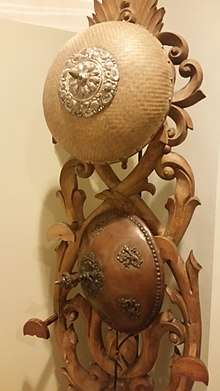Salakot


A salakót is a traditional wide-brimmed hat from the Philippines. It is often made of either rattan or Phragmites reeds, and is a Filipino traditional headdress similar to the iconic conical hat found in neighbouring Southeast and East Asian countries. The Visayans also call this headgear "sadok" or "sarok".[1]
History
The headress must have found itself taken along the Malay immigration to the Philippine Archipelago. Ancient Madja-as tradition recounts that the first Malay settlers in the archipelago purchased the valleys and plains of Panay Island from the native Aetas,[2] in exchange for a golden salakót and a very long pearl necklace called a manangyad, which touched the ground when worn by the wife of the Aeta chieftain.[3]
The custom of embellishing the salakót developed during the later part Spanish Era. Though normally worn by farmers, wealthy and landed Christian Filipinos and mestizos (especially the members of the nobility called the Principalía) would also wear the salakót. This class started to adopt a characteristic style of dress and carry regalia.[4][5] They wore a distinctive type of salakot made of more prized materials like tortoise shell. The special salakot of the ruling upper class was often adorned with ornate capping spike crafted in metals of value like silver, [6] or, at times, gold.[7] This headgear was usually embossed also with precious metals and sometimes decorated with silver coins or pendants that hung around the rim.[8] Many depictions of gobernadorcillos and cabezas de barangay would portray these colonial public functionaries as wearing ornate salakots. It was not uncommon for this class to wear salakót made of more valuable materials, such as tortoiseshell and precious metals.[9][10]
Cultural significance
The salakot is a common symbol for Filipino identity, often worn by the National personification Juan dela Cruz.
In 2012, Teofilo Garcia of Abra in Luzon, expert artisan of a special kind of salakot made of gourd (Lagenaria leucantha) was awarded by the National Commission for Culture and the Arts with the "Gawad sa Manlilikha ng Bayan" (National Living Treasures Award) for his dedication to the traditional craft of making gourd salakot, affirming the salakot (the object of his art) as one of the intangible cultural heritage of the Philippines under the traditional craftsmanship category.[11]
References
- ↑ Jesus T. Peralta, Ed., Jeonju: 2013, National Commission for Culture and the Arts, Philippines & International Information and Networking Centre for Intangible Cultural Heritage, Korea (co-publishers), p. 232.
- ↑ G. Nye Steiger, H. Otley Beyer, Conrado Benitez, A History of the Orient, Oxford: 1929, Ginn and Company, p. 120.
- ↑ G. Nye Steiger, H. Otley Beyer, Conrado Benitez, A History of the Orient, Oxford: 1929, Ginn and Company, p. 121.
- ↑ Cf. Foreman, John, ed. (1907). The Philippine Islands : a political, geographical, ethnographical, social and commercial history of the Philippine Archipelago, embracing the whole period of Spanish rule, with an account of the succeeding American insular government (book). New York: Charles Scribner's Sons, p. 223.
- ↑ BLAIR, Emma Helen & ROBERTSON, James Alexander, eds. (1904). The Philippine Islands, 1493–1898. Volume 17 of 55 (1609–1616). Historical introduction and additional notes by Edward Gaylord BOURNE; additional translations by Henry B. Lathrop. Cleveland, Ohio: Arthur H. Clark Company. ISBN 978-1426486869. OCLC 769945708, p. 331.
- ↑ Manuel Buzeta y Felipe Bravo, Diccionario geografico, estadistico, historico de las Islas Filipinas, Charleston, South Carolina: 2011, Nabu Press, Vol. I, p. 241.
- ↑ Laureano, Felix, ed. (1895). Recuerdos de Filipinas: Libro-Album (book) (in Español). Volumen Primero. Barcelona: A. Lopez Robert, p. 26.
- ↑ ROCES, Alfredo Reyes; CORDERO-FERNANDO, Gilda; QUIRINO, Carlos & GUTIERREZ, Manuel C, eds. (1977). Filipino Heritage: the Making of a Nation (10 vols). Manila: Lahing Pilipino Pub. ISBN 978-9718574010. OCLC 6088188. 1328526, Vol. 4, pp. 1106–1107.
- ↑ Alfredo R. Roces, et al., eds., Ethnic Headgear in Filipino Heritage: the Making of a Nation, Philippines: Lahing Pilipino Publishing, Inc., 1977, Vol. VI, pp. 1106-1107.
- ↑ Manuel Buzeta y Felipe Bravo, Diccionario geografico, estadistico, historico de las Islas Filipinas, Charleston, South Carolina: 2011, Nabu Press, Vol. I, p. 241.
- ↑ Jesus T. Peralta, Ed., Jeonju: 2013, National Commission for Culture and the Arts, Philippines & International Information and Networking Centre for Intangible Cultural Heritage, Korea (co-publishers), p. 232.